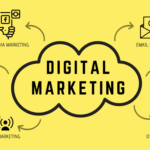
In today’s digital age, a website isn’t a luxury – it’s a necessity. It’s your online storefront, your digital brochure, and a powerful tool for connecting with customers and growing your business. But with so many businesses online, how can you ensure your website stands out? This blog delves into the power of website development and equips you with the knowledge to create a website that thrives.
Why Your Business Needs a Website
A well-developed website offers a multitude of benefits for your business:
- Establish Credibility and Trust: A professional website portrays a legitimate and trustworthy image. It allows you to showcase your brand identity, expertise, and value proposition, fostering trust with potential customers.
- 24/7 Global Reach: Your website is accessible to anyone with an internet connection, 24/7. This transcends geographical boundaries, allowing you to reach a global audience and expand your customer base.
- Enhanced Brand Awareness: A well-designed website serves as a digital hub for your brand. It allows you to control your brand narrative, promote your products or services, and build brand recognition.
- Lead Generation and Sales: Your website can be a powerful lead generation tool. By incorporating strategic calls to action and contact forms, you can convert website visitors into potential customers.
- Improved Customer Service: Your website can serve as a self-service portal for customers. Provide informative content like FAQs, product manuals, or knowledge bases to empower customers and reduce support inquiries.
- Cost-Effective Marketing: Compared to traditional marketing methods, website development offers a cost-effective way to promote your business and reach your target audience.
- Measurable Results: Website analytics tools provide valuable data on user behavior, allowing you to track website traffic, identify areas for improvement, and optimize your website for better results.
How Website Development Can Help You Achieve Your Business Goals
1. Define Your Goals and Target Audience:
The foundation of any successful website lies in understanding your goals and target audience. What do you aim to achieve with your website? Increase brand awareness, generate leads, or drive sales? Once you have a clear vision, create a buyer persona outlining the demographics and online behavior of your ideal customer.
2. User-Friendly Design and Navigation:
Your website should prioritize user experience (UX). A clean, intuitive design and well-organized navigation are crucial. Visitors should be able to find the information they need quickly and easily.
- What to do: Employ a responsive design that adapts seamlessly to different devices (desktop, mobile, tablet). Prioritize clear and concise visuals. Ensure a logical and consistent navigation structure with clear labels.
3. Content is King (and Queen):
High-quality, informative, and engaging content is essential for attracting and retaining website visitors.
- What to do : Create content relevant to your target audience’s needs and interests. Incorporate a variety of content formats like blog posts, infographics, videos, and case studies. Optimize your content with relevant keywords to improve search engine ranking.
4. Search Engine Optimization (SEO):
SEO is the practice of optimizing your website to rank higher in search engine results pages (SERPs). This increases organic website traffic and visibility for relevant search queries.
- What to do: Conduct keyword research to identify relevant keywords your target audience uses. Integrate those keywords naturally into your website content. Optimize your website’s title tags and meta descriptions.
5. Leverage the Power of Calls to Action (CTAs):
A strong call to action (CTA) tells visitors what you want them to do next. Whether it’s subscribing to your newsletter, contacting you for a quote, or making a purchase, clear CTAs are essential for driving conversions.
- What to do: Formulate clear, concise, and action-oriented CTAs. Place your CTAs strategically throughout your website, particularly on landing pages and high-traffic areas.
6. Integrate Analytics and Make Data-Driven Decisions:
Website analytics tools provide valuable insights into user behavior on your website. Utilize this data to track website traffic, identify areas for improvement, and optimize your website for better performance.
7. Mobile Optimization is a Must:
With the increasing use of mobile devices for browsing, a mobile-friendly website is no longer optional. Ensure your website offers a seamless user experience across all devices.
8. Security is Paramount:
Protecting your website and user data is crucial. Implement strong security measures, including SSL certificates and regular security updates, to safeguard your website and build user trust.







